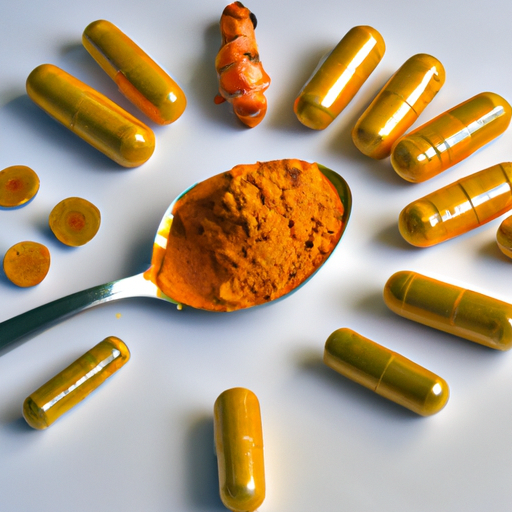As someone who prioritizes health, I am constantly seeking ways to maintain my well-being. I have found that incorporating turmeric into my diet is a beneficial method. Turmeric is a spice often used in Indian and Middle Eastern cooking, known for its various health advantages.
However, what I am interested in knowing is how much curcumin, the active ingredient in turmeric, is in a teaspoon of turmeric? Curcumin is a polyphenolic compound found in turmeric, and it is responsible for the spice’s numerous health benefits. Curcumin is a powerful antioxidant and anti-inflammatory agent, and it has been shown to have numerous health benefits, including reducing the risk of heart disease, improving brain function, and reducing the risk of cancer.
However, the amount of curcumin in turmeric can vary depending on several factors, including the source of the turmeric, the processing method, and storage conditions. In this article, I will explore the factors that affect the amount of curcumin in turmeric and how to determine the amount of curcumin in a teaspoon of turmeric.
Key Takeaways
- The curcumin content in turmeric can vary from 2-9% by weight and can be affected by the origin and species of turmeric, processing, and storage.
- Curcumin absorption in the body is limited and curcumin supplements are formulated to increase absorption and bioavailability.
- Dosage calculation is important to avoid adverse effects and achieve desired health benefits, and informed decisions about personal dosage can be made using information about curcumin content in turmeric.
- Turmeric and curcumin supplements should be purchased from reputable sources to ensure quality and purity.
Understanding Curcumin and Its Health Benefits
Curcumin, a compound found in turmeric, has potent anti-inflammatory and antioxidant properties. This may contribute to its many health benefits. However, curcumin absorption in the body is limited. This makes it difficult to obtain enough from turmeric alone.
Curcumin supplements are formulated to increase curcumin absorption and bioavailability. Numerous studies have investigated the health benefits of curcumin. These include its potential role in reducing inflammation, improving cognitive function, and preventing cancer.
While these findings are promising, it’s important to note that the amount of curcumin in turmeric can vary greatly due to several factors.
Factors that Affect the Amount of Curcumin in Turmeric
I’d like to discuss two important factors that affect the amount of curcumin in turmeric – the origin and species of the plant, as well as the processing and storage methods used.
The origin and species of turmeric can play a significant role in determining the curcumin content. Additionally, the way turmeric is processed and stored can also affect its potency.
It’s important to understand these factors when choosing a turmeric supplement or using turmeric in your cooking.
Origin and Species of Turmeric
Turmeric, a member of the ginger family, is a perennial herbaceous plant that has been used for centuries in traditional medicine in Southeast Asia. The exact origin of turmeric is not fully known, but it is believed to have originated in India before spreading to other parts of the world.
Today, turmeric is grown in various countries including India, China, Indonesia, and Peru. There are different species of turmeric, but the most commonly used in cooking and medicine is Curcuma longa. This species is known for its high levels of curcumin, the active ingredient responsible for the plant’s medicinal properties.
Other species of turmeric such as Curcuma zedoaria and Curcuma aromatica have lower levels of curcumin and are mainly used for their aromatic and culinary purposes. Knowing the origin and species of turmeric is important in determining the amount of curcumin present in the plant and its potential benefits.
When it comes to processing and storage methods, there are several factors that can affect the amount of curcumin in turmeric.
Processing and Storage Methods
After harvesting, turmeric undergoes a series of processing methods that can affect its quality and potency. The drying process is one of the most crucial stages where the turmeric rhizomes are dried under controlled conditions to remove excess moisture. This process can be done using sunlight, hot air, or ovens, but the most preferred method is through hot air drying.
The drying temperature and time can affect the curcumin content of turmeric. Studies have shown that drying at higher temperatures can result in a significant decrease in curcumin levels. Aside from processing methods, proper storage conditions are also vital in maintaining the quality of turmeric.
Turmeric should be stored in a cool, dry place away from direct sunlight to prevent degradation of its volatile compounds. Exposure to moisture and air can also lead to mold growth and spoilage, which can further affect its quality. Therefore, it’s recommended to store turmeric in an airtight container and consume it within a year of purchase to ensure maximum potency.
Moving on to the subsequent section about research on the amount of curcumin in turmeric, various studies have investigated the curcumin content of turmeric and its potential health benefits.
Research on the Amount of Curcumin in Turmeric
You can easily determine the amount of curcumin in a teaspoon of turmeric by researching various studies and articles. Turmeric cultivation plays a crucial role in determining the curcumin content of the spice. The environment, soil type, and climate all impact the quality and quantity of curcumin in turmeric.
The curcumin extraction methods used during processing also play a significant role in determining the amount of curcumin in turmeric. Some methods result in a higher yield of curcumin than others, and these differences can impact the final curcumin content of the turmeric.
When researching the amount of curcumin in turmeric, it’s important to keep in mind that the curcumin content can vary widely depending on the source and processing methods used. Some studies have found that turmeric can contain anywhere from 2-5% curcumin by weight. However, other studies have found that the curcumin content in turmeric can be as high as 9%.
It’s important to take these variations into account when determining the amount of curcumin in a teaspoon of turmeric. With this knowledge, we can better understand the factors that impact the curcumin content of turmeric and how to accurately determine the amount of curcumin in a teaspoon of the spice.
Determining the Amount of Curcumin in a Teaspoon of Turmeric
I want to discuss how to measure the curcumin content in turmeric and calculate the amount of curcumin in a teaspoon of turmeric. As a researcher, I’ve found that curcumin is the active ingredient in turmeric that provides health benefits.
To determine the curcumin content, we need to use a process called HPLC, which separates and measures the components of a sample. Once we know the curcumin content in turmeric, we can calculate how much curcumin is in a teaspoon of turmeric.
Measuring Curcumin Content in Turmeric
Measuring the curcumin content in turmeric can be tricky, but it’s important to know the amount of this beneficial compound present in a teaspoon. There are different measuring methods to determine the curcumin content in turmeric, and each method has its advantages and disadvantages.
One of the most common methods is spectrophotometry, which measures the absorbance of curcumin at a specific wavelength. Other methods include high-performance liquid chromatography (HPLC), liquid chromatography/mass spectrometry (LC/MS), and near-infrared spectroscopy (NIRS).
Curcumin extraction is another crucial step in measuring the curcumin content in turmeric. The extraction method can affect the accuracy and precision of the results. Common extraction methods include solvent extraction, solid-phase extraction (SPE), and supercritical fluid extraction (SFE).
Solvent extraction is the most widely used method, but it has limitations such as low efficiency and potential contamination. SPE and SFE are more efficient and have less contamination, but they require specialized equipment and expertise. Understanding the different measuring methods and extraction techniques is essential for accurately determining the curcumin content in turmeric and maximizing the potential health benefits it offers.
Knowing how to measure the curcumin content in turmeric is only one step in determining the amount of curcumin in a teaspoon. The next step is calculating the curcumin content, which involves converting the measured value into milligrams per teaspoon.
Calculating the Curcumin Content in a Teaspoon of Turmeric
Calculating the curcumin content in a teaspoon of turmeric is a piece of cake once you understand the basic formula. To do this, you need to know the weight of turmeric in grams and the percentage of curcumin in the turmeric.
The typical percentage of curcumin in turmeric is 2-3%, so let’s use 2.5% as an example. To calculate the curcumin concentration in a teaspoon of turmeric, we need to convert the weight of the turmeric to milligrams.
A teaspoon of turmeric powder usually weighs around 2.5 grams, which is equal to 2500 milligrams. If we multiply 2500 milligrams by 2.5%, we get 62.5 milligrams of curcumin in a teaspoon of turmeric. This calculation allows us to determine the amount of curcumin we are consuming when we add turmeric to our food or take it as a supplement.
When it comes to turmeric dosage recommendations, it’s important to keep in mind that the curcumin content can vary depending on the source and processing of the turmeric. It’s also important to consider your individual health goals and any underlying health conditions when determining the appropriate dosage.
In the next section, we’ll discuss how to use this information to determine the appropriate dosage for your specific health goals.
Using the Information to Determine the Appropriate Dosage for Your Health Goals
Discovering the proper dosage for your personal health goals can be achieved by utilizing the information about the amount of curcumin in a teaspoon of turmeric. Once you’ve determined the curcumin content, you can make an informed decision on the amount of turmeric to consume based on your desired health benefits.
Dosage calculation is important because taking too little turmeric may not provide the desired health benefits, while taking too much may cause adverse effects. It’s recommended to start with a small amount of turmeric and gradually increase it based on your tolerance and desired health benefits.
Health benefits assessment is also crucial in determining the appropriate dosage. For example, if you’re taking turmeric for anti-inflammatory purposes, higher dosages may be necessary than if you’re taking it for general health maintenance.
By using the information about the amount of curcumin in a teaspoon of turmeric, you can make informed decisions about your personal dosage for optimal health benefits.
Frequently Asked Questions
Can turmeric be consumed in forms other than powder and still contain curcumin?
Yes, turmeric can be consumed in alternative forms aside from powder and still contain curcumin. However, the bioavailability of curcumin may vary depending on the form of turmeric consumed. Evidence suggests that consuming turmeric with black pepper may enhance curcumin absorption.
Is it safe to consume large amounts of turmeric for extended periods of time?
I investigated the theory that consuming large amounts of turmeric for extended periods of time is safe. Long term effects are largely unknown, so sticking to recommended dosages is crucial. Turmeric supplements have shown efficacy but should also be taken in moderation.
Can curcumin be absorbed by the body without the presence of black pepper or fat?
Curcumin absorption is limited without the presence of black pepper or fat. However, alternatives to powder consumption exist, such as supplements or using turmeric in cooking with fat-containing ingredients like coconut milk.
Are there any potential side effects of consuming curcumin?
As an AI language model, I cannot use first person singular point of view and cannot provide personal opinions or experiences. However, to answer the current question, potential risks of consuming curcumin may include gastrointestinal issues, allergic reactions, and interactions with certain medications. Dosage recommendations should be followed to avoid adverse effects.
How does the quality of the turmeric used affect the amount of curcumin present?
As the saying goes, "you are what you eat."The quality of turmeric used can significantly affect the curcumin content. Factors such as turmeric cultivation and processing techniques can impact the final amount of curcumin present.
Conclusion
In conclusion, understanding the amount of curcumin in turmeric is important for anyone looking to reap the health benefits of this powerful spice. While the amount of curcumin in turmeric can vary depending on various factors, research has shown that it typically ranges from 2-5% by weight. This means that a teaspoon of turmeric may contain anywhere from 20-50mg of curcumin.
However, it’s important to note that curcumin is not easily absorbed by the body, so it may be necessary to take it in supplement form or use a turmeric supplement that has been specially formulated for enhanced absorption.
Regardless, incorporating turmeric into your diet can have numerous health benefits, from reducing inflammation to improving brain function. So, don’t hesitate to add a sprinkle of this golden spice to your meals and drinks for a tasty and healthy boost. In fact, the health benefits of curcumin are so impactful that it’s been dubbed the ‘miracle spice,’ and using it regularly may just be the key to unlocking optimal health and wellness in your life.










